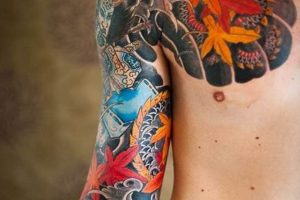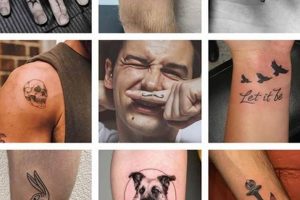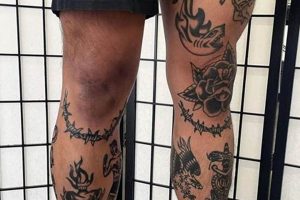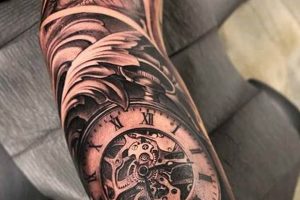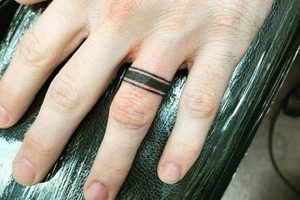The chest offers a prominent canvas for male body art, allowing for large, detailed designs or smaller, simpler pieces. Examples range from intricate full-chest murals depicting mythological scenes or portraits to minimalist geometric patterns centered near the sternum. The pectoral muscles provide a dynamic surface that can enhance the three-dimensional aspects of a skilled tattoo artist’s work.
Choosing the chest as a location for a tattoo is often motivated by its visibility and symbolic significance. It represents strength, masculinity, and a close connection to the heart and personal beliefs. Historically, chest tattoos have been used to display family crests, declarations of love, or symbols of protection and spirituality. This area allows for artwork that can be easily concealed with clothing or proudly displayed, offering versatility and personal expression.
Factors influencing design choices include individual style preferences, pain tolerance, and future career considerations. Popular styles for chest tattoos encompass realism, traditional Japanese, tribal, and biomechanical, among others. This article will further explore various design concepts, the tattooing process, aftercare, and important considerations for those contemplating a chest tattoo.
Tips for Chest Tattoos
Careful planning is essential for a successful chest tattoo. These tips offer guidance for navigating the process.
Tip 1: Research Artists Thoroughly: Seek artists specializing in the desired style. Review portfolios and client testimonials to assess quality and experience.
Tip 2: Consider Pain Tolerance: The chest is considered a moderately painful area for tattooing. Discuss pain management options with the chosen artist.
Tip 3: Plan for Healing Time: Chest tattoos require significant healing time due to their size and location. Be prepared to follow aftercare instructions diligently.
Tip 4: Choose a Timeless Design: Trends change. Opt for imagery that holds personal meaning and will stand the test of time.
Tip 5: Factor in Body Changes: Significant weight fluctuations or muscle growth can distort a chest tattoo. Maintain a stable physique or consult with an artist about design adaptability.
Tip 6: Think About Placement and Size: The size and placement of the tattoo should complement the body’s natural contours. Consider how the design will interact with existing or planned tattoos.
Tip 7: Consult with the Artist: Open communication with the artist is crucial. Discuss design ideas, placement, and any concerns before committing to the tattoo.
By considering these tips, individuals can ensure a positive tattooing experience and a piece of body art they will cherish for years to come.
These considerations contribute to a well-informed decision, resulting in a tattoo that reflects personal style and stands the test of time.
1. Placement
Placement is a critical factor in chest tattoo design, influencing the overall aesthetic and how the artwork interacts with the body’s natural contours. Careful consideration of placement ensures the tattoo complements the individual’s physique and aligns with the desired visual impact.
- Central Chest Placement
Designs centered on the sternum offer a symmetrical and balanced look, often featuring imagery with symbolic significance. Examples include mandalas, religious iconography, or family crests. This placement emphasizes the heart and projects a sense of strength and conviction.
- Pectoral Placement
Utilizing the pectoral muscles as a canvas allows for larger, more dynamic designs. Images such as animals, mythical creatures, or biomechanical art can be effectively showcased here. The curvature of the muscles can enhance the three-dimensional aspects of the tattoo, creating a visually striking effect.
- Shoulder and Chest Integration
Extending a design across the shoulder and onto the chest creates a cohesive flow, visually connecting the two areas. This placement is suitable for larger pieces like Japanese-style dragons, tribal patterns, or intricate floral designs. It provides an expansive canvas for complex narratives and detailed artwork.
- Clavicle and Upper Chest Placement
Smaller designs or script tattoos placed near the clavicle or upper chest offer a more subtle approach. Quotes, names, or small symbols can be discreetly displayed in this area. This placement is suitable for individuals seeking a less prominent yet meaningful tattoo.
The chosen placement significantly impacts the overall composition and message conveyed by the tattoo. Understanding these different placement options allows individuals to select the location that best suits their desired aesthetic, the size and complexity of the design, and the personal significance of the artwork.
2. Size and Scale
Size and scale are crucial design elements for chest tattoos, impacting the visual balance, detail complexity, and overall aesthetic. Appropriate scaling ensures the design harmonizes with the individual’s physique and effectively conveys the intended message.
- Small-Scale Designs
Smaller tattoos, often minimalist or symbolic, can be placed strategically on the upper chest, near the clavicle, or subtly integrated within a larger piece. These designs offer understated elegance and can be easily concealed if desired. Examples include single-word scripts, small geometric patterns, or minimalist representations of animals or objects. Small-scale tattoos offer a discreet yet impactful option for individuals seeking a less prominent design.
- Medium-Scale Designs
Medium-sized tattoos offer a balance between detail and coverage, typically focusing on a central image or theme. They can be placed centrally on the chest or positioned over a pectoral muscle. Popular examples include portraits, animal heads, or intricate mandalas. This scale allows for moderate detail while maintaining a balanced proportion relative to the chest area.
- Large-Scale Designs
Large-scale tattoos often span a significant portion of the chest, encompassing intricate details and complex imagery. These designs can extend across the pectorals, shoulders, and even integrate with other existing tattoos. Examples include full-chest murals, detailed depictions of mythological scenes, or extensive tribal patterns. Large-scale pieces make a bold statement and require significant commitment due to the time and cost involved.
- Proportion and Body Type
The chosen size and scale should complement the individual’s body type and chest dimensions. A large design on a smaller frame might appear overwhelming, while a small tattoo on a larger chest could appear lost or insignificant. Careful consideration of proportion ensures the tattoo harmonizes with the body’s natural contours and creates a visually appealing result. Consulting with a skilled tattoo artist is crucial for determining appropriate sizing and placement based on individual physique.
Ultimately, the ideal size and scale depend on personal preference, the complexity of the design, and the desired visual impact. A thoughtful approach to these elements ensures the chest tattoo becomes a well-integrated and aesthetically pleasing piece of body art.
3. Style and Imagery
Style and imagery are integral to the design process for chest tattoos, significantly impacting the final aesthetic and the conveyed message. A harmonious relationship between style and imagery ensures the tattoo reflects the individual’s personality, beliefs, and artistic preferences. Selecting an appropriate style significantly influences the visual impact and longevity of the tattoo.
Several popular styles lend themselves well to chest pieces. Realism, with its focus on lifelike detail and accurate representation, suits portraits, animals, or natural landscapes. The chest’s broad surface provides ample space for the intricate shading and detail required by this style. Traditional Japanese tattoos, characterized by bold lines, vibrant colors, and iconic imagery like dragons, koi fish, and samurai, are another popular choice. The chest’s curvature complements the flowing lines and dynamic compositions typical of this style. Tribal designs, often incorporating geometric patterns and symbolic elements, offer a powerful and historically rich aesthetic. The chest’s central location enhances the tribal tattoo’s traditional significance as a display of strength and heritage. Biomechanical tattoos, blending organic and mechanical elements, create a futuristic and visually arresting effect. The chest’s musculature can be incorporated into these designs, enhancing the illusion of interwoven flesh and machine. Choosing the right style significantly influences the artist selection process, as artists often specialize in specific techniques and aesthetics.
Imagery selection is deeply personal and should resonate with the individual’s values and experiences. Animals, representing strength, freedom, or spiritual guidance, are frequent choices. Mythological creatures, like dragons and phoenixes, symbolize power, transformation, and resilience. Religious iconography can express faith and devotion. Geometric patterns, often incorporating sacred geometry principles, offer a visually striking and symbolic representation of balance and interconnectedness. Quotes, names, and dates commemorate loved ones or significant life events. The chosen imagery, when executed in a fitting style, transforms the chest into a powerful canvas for self-expression and storytelling. Careful consideration of both style and imagery results in a meaningful and aesthetically impactful chest tattoo that will endure the test of time. This understanding allows individuals to make informed decisions, collaborating effectively with artists to create personalized and resonant works of art.
4. Artist Selection
Artist selection is paramount when considering a chest tattoo. The chest’s prominent location necessitates a skilled artist capable of executing the desired design flawlessly. A poorly executed chest piece can be difficult and costly to correct or cover up. Different artists specialize in various styles. An artist proficient in photorealism might not be the best choice for a traditional Japanese tattoo. Matching artistic style to the chosen design ensures a cohesive and aesthetically pleasing result. For example, an individual seeking a realistic portrait should seek an artist with a demonstrable portfolio of successful portrait work. Similarly, someone envisioning a large-scale biomechanical piece should choose an artist specializing in that distinct style. Researching artists, reviewing portfolios, and scheduling consultations are essential steps in the selection process. This due diligence minimizes the risk of dissatisfaction and ensures the final product aligns with the individual’s vision.
Beyond technical skill, an artist’s experience with chest tattoos is crucial. The chest’s unique contours and skin texture require specific expertise. An experienced artist understands how the design will interact with the body’s movement and how to adapt the artwork to the individual’s physique. They can also advise on appropriate sizing, placement, and design elements that complement the chest area. Furthermore, a reputable artist adheres to strict hygiene standards, minimizing the risk of infection and ensuring a safe tattooing experience. A thorough consultation with a prospective artist should cover design details, placement considerations, pain management strategies, and aftercare procedures. This open communication establishes a collaborative relationship, fostering trust and ensuring both artist and client are aligned on the project’s vision.
Choosing the right artist significantly impacts the quality, longevity, and overall satisfaction with a chest tattoo. Investing time and effort in the selection process ultimately leads to a piece of body art that reflects the individual’s vision and stands the test of time. A well-executed chest tattoo, created by a skilled and experienced artist, becomes a source of pride and personal expression, enhancing the individual’s aesthetic and conveying a meaningful message.
5. Aftercare Practices
Aftercare practices are essential for ensuring the longevity and vibrancy of chest tattoos. The chest area, subject to friction from clothing and exposure to sunlight, requires diligent care during the healing process. Neglecting proper aftercare can lead to infection, fading, and blurring of the design, compromising the aesthetic of the tattoo and potentially causing health complications. Following a comprehensive aftercare regimen is not merely a suggestion; it is a critical component of the overall tattoo process, directly impacting the final result. For example, failing to keep the tattoo clean and moisturized can lead to scab formation, which can pull ink from the skin during healing, resulting in patchy or faded areas. Similarly, exposing a healing tattoo to excessive sunlight can cause the ink to break down, leading to premature fading and dulling of colors, especially crucial for vibrant and detailed chest pieces.
Effective aftercare involves keeping the tattoo clean, moisturized, and protected from sun exposure. Regularly washing the tattoo with a mild, fragrance-free soap and applying a thin layer of unscented moisturizer prevents dryness and cracking, promoting healthy skin regeneration. Avoiding tight-fitting clothing minimizes friction and irritation, allowing the skin to breathe and heal properly. Sun protection is crucial, especially during the initial healing phase. Applying a high-SPF sunscreen once the tattoo is fully healed helps preserve the vibrancy of the ink and prevents premature fading. The specific aftercare instructions provided by the tattoo artist should be followed meticulously, as they may vary depending on the individual’s skin type, the size and complexity of the tattoo, and the inks used. For instance, larger chest pieces covering a significant area might require more frequent moisturizing and specialized bandaging techniques compared to smaller, simpler designs.
Proper aftercare practices are intrinsically linked to the success of a chest tattoo. These practices are not merely an afterthought but an integral part of the entire process, from initial design conception to the final healed result. Diligent adherence to aftercare guidelines safeguards the investment made in the tattoo, preserving its vibrancy and clarity for years to come. Ignoring aftercare can undermine the artistry and meaning behind the tattoo, emphasizing the critical connection between meticulous aftercare and the long-term aesthetic of chest tattoos. Understanding this connection empowers individuals to actively participate in preserving their body art, ensuring their chosen design remains a source of pride and personal expression.
Frequently Asked Questions
This section addresses common inquiries regarding chest tattoos, providing factual information to assist individuals in making informed decisions.
Question 1: How painful are chest tattoos?
Pain levels vary based on individual tolerance, but the chest is generally considered a moderately painful area due to the thin skin and proximity to bone and nerve endings. The sternum and nipple areas are typically more sensitive.
Question 2: How long does a chest tattoo take to heal?
Healing time typically ranges from 4 to 6 weeks, depending on the size and complexity of the design. Larger pieces may take longer to fully heal.
Question 3: How much does a chest tattoo cost?
Cost varies based on factors such as artist experience, design intricacy, size, and geographic location. It’s advisable to consult with multiple artists to obtain accurate quotes.
Question 4: Can chest tattoos be covered up easily?
Chest tattoos are relatively easy to conceal with clothing. However, certain professions may require covering visible tattoos, which should be considered beforehand.
Question 5: Will a chest tattoo stretch or distort over time?
Significant weight fluctuations or muscle growth can affect the appearance of a chest tattoo. Maintaining a stable weight and physique helps minimize distortion.
Question 6: What are the potential risks associated with chest tattoos?
As with any tattoo, risks include infection, allergic reactions to ink, and scarring. Choosing a reputable artist adhering to strict hygiene protocols minimizes these risks.
Careful consideration of these frequently asked questions provides valuable insights for individuals contemplating a chest tattoo. Understanding the process, potential risks, and aftercare requirements enables informed decisions and contributes to a positive tattooing experience.
The following section will explore various design ideas in greater detail, providing inspiration and guidance for choosing the perfect chest piece.
Conclusion
Exploration of chest tattoos for men reveals a complex interplay of design elements, artistic skill, and personal significance. Placement, size, style, and imagery converge to create a powerful statement of individuality. Careful selection of a skilled artist specializing in the desired aesthetic is paramount for achieving a high-quality, lasting piece. Diligent aftercare practices ensure the vibrancy and longevity of the tattoo, protecting the investment and preserving the intended artistic expression.
A chest tattoo represents a significant commitment, both aesthetically and personally. Thorough consideration of design choices, artist selection, and aftercare procedures transforms this prominent canvas into a powerful medium for self-expression, storytelling, and artistic exploration. The chest, a canvas close to the heart, offers a unique opportunity to display meaningful imagery that resonates with the individual’s identity and values, becoming an enduring testament to personal narratives and artistic vision.



